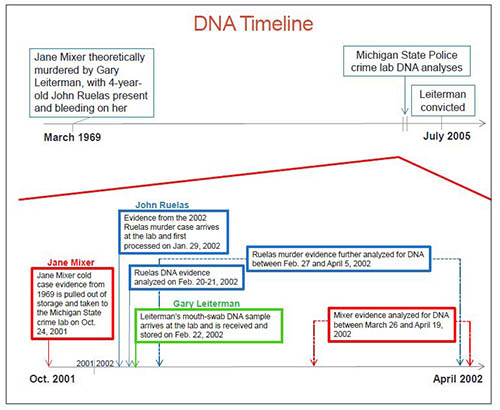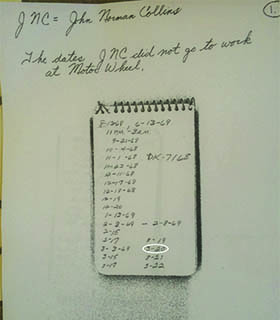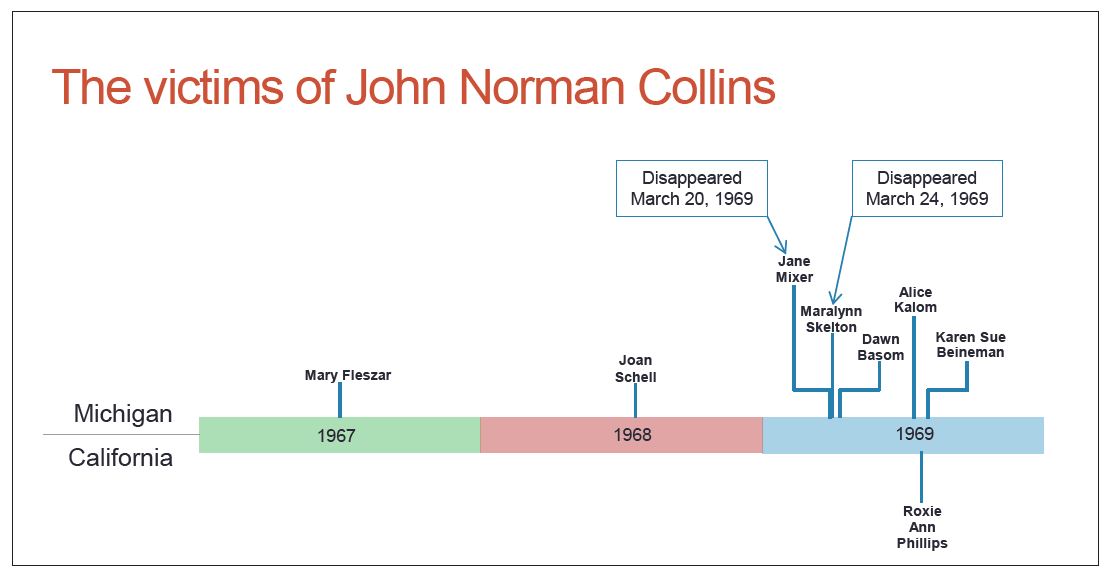Whether Eyewitness Memory or DNA, Contaminated Forensic Evidence Is Unreliable
There is an almost universal impression that eyewitness memory is inherently unreliable, even though research shows that eyewitness evidence is quite reliable so long as proper procedures are employed (see sidebar on p. 31). This misperception may be largely due to public awareness of cases in which people have been wrongfully convicted of crimes on the basis of eyewitness testimony that later was determined to be unreliable. By the same token, DNA evidence is largely viewed as unassailable, in part because of its publicized role in overturning wrongful convictions. But in reality, DNA evidence can be unreliable in the same way that eyewitness-identification evidence can be unreliable — namely, when the evidence is contaminated.
As part of the “Psychology & Law” class that I teach, I set out to illustrate the point that contaminated forensic evidence of any kind (not just contaminated eyewitness evidence) can lead to a wrongful conviction. Because DNA evidence generally is regarded as the gold standard of forensic evidence, I decided to use that as my example. To find an illustrative case, I conducted a Google search using terms like “DNA contamination” and “wrongful conviction.” That’s how I stumbled upon the story of Gary Leiterman.
The Conviction
The story begins with a tragic event: 23-year-old University of Michigan law student Jane Mixer was shot in the head with a .22-caliber gun in the early morning hours of March 21, 1969, and her body was dumped in a graveyard. She had arranged to meet a stranger named David Johnson at the student union on the evening of March 20, 1969, and he was supposed to drive her home to Muskegon, Michigan (about a 3-hour drive). She never made it. She was initially thought to be a victim of the infamous “Co-Ed Killer” (later found to be John Norman Collins), who was murdering women in the area at the time, but no direct link to him was ever established.
Mixer’s murder remained unsolved until a cold-case analysis of DNA from the crime scene was conducted in a Michigan State Police forensic lab in 2002. That analysis uncovered two previously undetected DNA profiles that matched the profiles of two men who were included in a federal DNA database because they had recently committed crimes. One of those men was John Ruelas, who murdered his mother in early 2002. His DNA was found on a blood spot taken from Mixer’s hand in 1969. The other was Leiterman, who recently had forged a prescription for pain medication. His DNA was found on a piece of pantyhose that Mixer had been wearing that day. Because Ruelas was only 4 years old in 1969, he was ruled out as a suspect, so only Leiterman remained a suspect. In 2005, he was sentenced to life in prison without the possibility of parole.
The discovery of DNA from Ruelas on the Mixer evidence should have been seen as an indication of potential contamination problems. Instead, the prosecution posed the theory that Leiterman killed Mixer and left his DNA at the crime scene in 1969 and that 4-year-old Ruelas also was there and somehow left a drop of blood on Mixer. (No connection between Leiterman and Ruelas has ever been established.) To this day, Collins is widely believed to have murdered at least seven women between 1967 and 1969, and he was convicted in 1970 for one of those murders. However, because no direct physical evidence linked Collins to Mixer’s murder, the prosecution assumed he was innocent of this particular crime.
The Contamination
The prosecution’s theory seems unaccountably accepting of the idea that a 4-year-old with no apparent connection to Leiterman was present and also bleeding when Mixer was murdered. Then again, any acknowledgment that the detection of Ruelas’s DNA might reflect an error would only help the defense. Indeed, Leiterman’s defense attorney, pointing out that DNA samples of all three people were analyzed in the same lab at nearly the same time, proposed that the two samples of DNA appeared on the crime-scene evidence because of inadvertent contamination. According to the defense, the Mixer evidence likely was contaminated with DNA from both Ruelas and Leiterman, and it was the obvious suspect, Collins, who committed the crime.
The timing of the DNA analyses is striking (Fig. 1). On October 24, 2001, the Mixer evidence from 1969 was pulled out of storage and taken to the Michigan State Police crime lab for processing. It was analyzed in March and April of 2002. Independently, evidence from the 2002 Ruelas murder case arrived at the lab on January 29, 2002, and was analyzed on February 20 and 21, 2002. At this point, it was unclear who had murdered Ruelas’s mother, so the evidence was sent to the lab to help with the investigation. On February 22, 2002, a mouth swab from Leiterman arrived in the lab for initial processing so that his DNA profile could be entered into the federal database.
Keep in mind that these three cases, aside from being handled in the same lab at about the same time, were entirely unrelated when Leiterman’s DNA sample arrived on February 22 (the green arrow in Fig. 1).

Figure 1
The possibility of contamination looms particularly large in light of the improbable Ruelas DNA evidence. Additionally, the results of lab tests showed that Leiterman’s DNA on the pantyhose was not blood or semen but might have been saliva, such as what was taken in his recent mouth-swab sample. Yet during Leiterman’s 2005 trial, lab technicians and supervisors adamantly maintained that proper laboratory procedures (e.g., sterilization procedures, storage protocols, contamination tests, etc.) had been followed at all times. Moreover, the evidence from the three different cases was analyzed in different physical locations in the lab on different days, thereby rendering cross-contamination (even from unnoticed and thus unrecorded events) a virtual impossibility, in their view.
Here’s the problem: To accept their interpretation of the evidence, you would have to further accept that Ruelas and Leiterman were together on the night that Mixer was murdered (estimated to have occurred between midnight and 3 a.m.), that 4-year-old Ruelas somehow bled on Mixer at that time, and that the independent processing of the Ruelas and Leiterman samples in the same lab within a day of each other 33 years later — close in time to when the Mixer evidence also was being analyzed — actually was just a remarkable coincidence (Fig. 1). To many observers, myself included, it is an inconceivable set of coincidences.
Given the inconclusive nature of the DNA evidence, convicting Leiterman of the premeditated murder of Mixer would only make sense if compelling corroborating evidence of guilt also existed. But there was no such evidence. A handwriting expert testified that two words written on a phone book found in the university union building were, with a high probability, written by Leiterman (thereby establishing the one and only connection between him and the location of Mixer’s abduction more than 30 years earlier), but another handwriting expert testified that it was highly unlikely that Leiterman wrote those words.[1] Leiterman, an avid hunter, owned a .22-caliber gun in 1969 (one of the most commonly owned guns at that time; Collins owned one, too); however, the gun was long gone, so there was no way to match it to the bullets that killed Mixer.
And that’s it. Leiterman and his family vehemently maintained his innocence (and do to this day).
The (Many Other) Coincidences
The DNA story alone is disturbing enough because it involves too many coincidences to believe, but there are in fact many more unlikely coincidences that you also are required to believe if you are to accept the prosecution’s theory that Leiterman is guilty (instead of accepting the much simpler possibility of DNA contamination). Don’t forget that Collins coincidentally was killing young women — and coincidentally was picking most of them up near university student union buildings — in that same area and at that same time. Details of his activities — and the evidence pointing to his guilt in most of the murders he is suspected of having committed — can be found in Gregory Fournier’s new book about Collins, Terror in Ypsilanti: John Norman Collins Unmasked. Fournier understandably does not include Mixer among the serial killer’s presumed victims because there is no direct evidence linking Collins to Mixer and because Leiterman is in prison for having committed that crime. But there are coincidences galore that point to Collins.
Collins shot at least one of his victims — coincidentally, another Michigan graduate student and, coincidentally, with a .22-caliber gun — 10 weeks after Mixer was murdered. On the night she disappeared, Mixer was waiting to be picked up by someone named “David Johnson.” No connection between that name and Leiterman was ever established, but, coincidentally, Collins lived with someone named David Johnson, with whom he had known conflicts. Fournier speculates that if Collins did commit the crime, he may have been trying to implicate Johnson in the murder of Mixer.

Figure 2
Some doubt that Collins killed Mixer because there were notable differences between her murder and the murders of the seven women for which he is the prime suspect. Most notably, Mixer was not raped and mutilated, as most of Collins’s other victims were. However, her tights had been pulled down, implying a sexual motive. In addition, a sanitary napkin was still in place, which might explain why an attempted rape was abandoned: Collins was repulsed by menstruation (James, 1991, p. 48). Many other aspects of Mixer’s murder were coincidentally quite similar to those of the other murders committed by Collins (e.g., a ligature was tied tightly around her neck; she was killed elsewhere and her body dumped; she was shot twice in the head with a .22; and she had been picked up at a student union building).
The murder of Mixer was estimated to have occurred between midnight and 3 a.m. on March 21, 1969. What was Collins doing at that time? It seems like an obvious question. Inexplicably, this issue did not come up at the 2005 trial, but I contacted a former police officer named Larry Matthewson who worked on the investigation and who was assigned the task of finding out whether Collins showed up at work on the nights that the women he was suspected of killing disappeared. At the time, Collins worked the 11 p.m. to 3 a.m. shift at the Motor Wheel auto parts factory. According to contemporaneous notes made by Matthewson, Collins missed his work shift the night Mixer disappeared (Fig. 2).
Collins is widely believed to have killed his first victim in the summer of 1967 and his second victim a year later in the summer of 1968. Approximately 8 months after that, a few days after Leiterman supposedly murdered Mixer, Collins initiated a greatly accelerated phase of killing (Fig. 3). This new phase theoretically began on March 24, 1969. Over the next 4 months, he is suspected of murdering five more women (not counting Mixer), including one who was murdered during a quick trip he made to California. Collins eventually was convicted of the last murder in the series (that of Karen Sue Beineman), and he remains in prison to this day. It is no great stretch of the imagination to suppose that his accelerated murder spree began on March 20, 1969, instead of on March 24, 1969.

Figure 3
The Conclusion
On my first try, I found the example I was looking for to illustrate the point for my students that contaminated forensic evidence of any kind — not just contaminated eyewitness evidence — can lead to a wrongful conviction. You simply have to accept too many unlikely coincidences to believe that Leiterman is guilty, both with respect to events in the DNA lab and with respect to events involving Collins. The alternative explanation — that Leiterman is innocent of the Mixer murder — requires only that you accept the glaring possibility of unnoticed contamination in the Michigan State Police crime lab. That is certainly my interpretation of what happened, and it is what motivated me to write this article. Beyond the tragic specifics of this case, the larger message is one that we, as scientists, already know (or should know) very well: Our confidence in the evidence is only as good as the methods we use to produce that evidence in the first place.
References
Fournier, G. A. (2016). Terror in Ypsilanti: John Norman Collins unmasked. Tucson, AZ: Wheatmark.
Garrett, B. (2011). Convicting the innocent: Where criminal prosecutions go wrong. Cambridge, MA: Harvard University Press.
James, E. (1991). Catching serial killers: Learning from past serial murder investigations. Lansing, MI: International Forensic Services.
National Research Council (2009). Strengthening forensic science in the United States: A path forward. Washington, DC: The National Academies Press.
National Research Council (2014). Identifying the culprit: Assessing eyewitness identification. Washington, DC: The National Academies Press.
Wells, G. L., & Bradfield, A. L. (1998). “Good, you identified the suspect”: Feedback to eyewitnesses distorts their reports of the witnessing experience. Journal of Applied Psychology, 83, 360–376.
Wells, G. L., Small, M., Penrod, S., Malpass, R. S., Fulero, S. M., & Brimacombe, C. A. E. (1998). Eyewitness identification procedures: Recommendations for lineups and photospreads. Law and Human Behavior, 23, 603–647.
Wixted, J. T., Mickes, L., Clark, S. E., Gronlund, S. D., & Roediger, H. L. (2015). Initial eyewitness confidence reliably predicts eyewitness identification accuracy. American Psychologist, 70, 515–526.
Wixted, J. T., Mickes, L., Dunn, J. C., Clark, S. E., & Wells, W. (2016). Estimating the reliability of eyewitness identifications from police lineups. Proceedings of the National Academy of Sciences, USA, 113, 304–309.
Wixted, J. T., & Wells, G. L. (2016). The relationship between eyewitness confidence and identification accuracy: A new synthesis. Manuscript submitted for publication.
[1]1 Not only did the experts disagree, but the scientific validity of handwriting analysis itself remains an open question (National Research Council, 2009).





Comments
Any could be unreliable. it all comes down to if it’s handled right
APS regularly opens certain online articles for discussion on our website. Effective February 2021, you must be a logged-in APS member to post comments. By posting a comment, you agree to our Community Guidelines and the display of your profile information, including your name and affiliation. Any opinions, findings, conclusions, or recommendations present in article comments are those of the writers and do not necessarily reflect the views of APS or the article’s author. For more information, please see our Community Guidelines.
Please login with your APS account to comment.